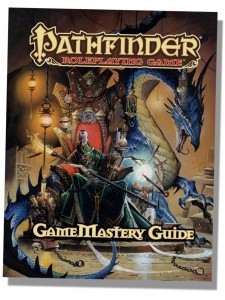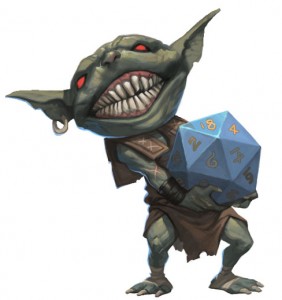 The Paizo GameMastery Guide is an excellent companion to the Pathfinder RPG Core Rule Book. The Core Rulebook combines all the rules you used to find in the old D&D 3.5 Player’s Handbook and Dungeon Master’s Guide into one book, but there was much more ground to cover, especially for the Game Master. Enter the GameMastery Guide, full of advice, ideas and rules for new and experienced Game Masters alike!
The Paizo GameMastery Guide is an excellent companion to the Pathfinder RPG Core Rule Book. The Core Rulebook combines all the rules you used to find in the old D&D 3.5 Player’s Handbook and Dungeon Master’s Guide into one book, but there was much more ground to cover, especially for the Game Master. Enter the GameMastery Guide, full of advice, ideas and rules for new and experienced Game Masters alike!
What to learn more? Read on…
The Paizo GameMastery Guide for the Pathfinder RPG is a full color 319 page supplement for the Game Master. The book is a mixture of advice for the GM and new rules and ideas to use in the game. Upon first giving the book a once over I was disappointed that it did not include more rules and dwelt so much on advice. I am terrible at taking advice, self help books are not for me, and another book on how to run a game, the roles of players, how to deal with situations at the table is not my cup of tea.
But once I sat down and actually read the book I found much of the advice precise, not preachy and, overall, very practical. Granted some of the topics may be things you already know if you are an experienced GM, but there are some gems in there. I particularly liked the side bars accompanying the text, like options for when the villain must escape, or avoiding overwork when creating NPCs!
 The first three chapters are mostly general advice on preparing for and running the game, and player characters. There are some gems in here, but many things that you have read before in other RPG advice books. For me the book really began after chapter four.
The first three chapters are mostly general advice on preparing for and running the game, and player characters. There are some gems in here, but many things that you have read before in other RPG advice books. For me the book really began after chapter four.
The chapter on NPCs has advice on their creation, including a useful discussion on villains, ways to generate background, quirks, occupations, etc., great ideas to make your NPCs memorable. The boon rules, by which NPCs can grant gifts or benefits to players, I found particularly inspired and another great way to reward your players in non-monetary ways.
This takes me to chapter five, rewards! It covers the practical aspects of rewards in an RPG context, from experience, to treasure, to intangibles, but goes further to discuss dealing with problematic magic items, wishes and spell research. I loved the discussion on coins and the idea of enhanced components that affect how spells work. This was briefly discussed, but for some reason it really got the gears in my head turning.
The world creation chapter covered excellent ground, even for a long time world builder like me. An excellent list of questions to ask when creating a world, a discussion on geography; and I was pleasantly surprised by the discussion of different cultures, their characteristics and ideas on how these would impact the game, all concise, but very useful.
Chapter 7, on adventures, covered a LOT of ground, from the planes and the rules governing them, taverns and urban adventures. I loved the urban stat block, with modifiers to skills used in the city depending on things like corruption, crime, law, among other variables. The rules for adventures in the wilderness and open water were particularly useful for my current campaign, and I loved the fast play ship to ship combat. These rules will be used soon in my game!
The Advanced Topics section covers a grab bag of ideas. There is a lot of crunch in this chapter. My favorites were chases (my players better get ready for one this week), disasters (think big scale, even campaign shattering events), haunts (a mix of a trap and a hunting, very interesting application) and the rules for sanity and drugs in the pathfinder RPG.
 But my favorite, and so far most useful, chapter of the book is Chapter 9, the NPC Gallery. It includes NPCs for different situations common to role playing games: an encounter on the road, a gladiator arena, facing an evil cult, consulting a seer, and more. Each two page section has a blurb about the situation or location and three NPCs, usually one low level, a mid level, and a mid to high level NPC. These are full write-ups with equipment, notes, all in all an excellent resource. Since getting the book I’ve used this chapter more than any other, reskinning the different NPCs. Change an item here, a detail there and you have endless NPC combinations. These 50+ pages alone made the book worth its price!
But my favorite, and so far most useful, chapter of the book is Chapter 9, the NPC Gallery. It includes NPCs for different situations common to role playing games: an encounter on the road, a gladiator arena, facing an evil cult, consulting a seer, and more. Each two page section has a blurb about the situation or location and three NPCs, usually one low level, a mid level, and a mid to high level NPC. These are full write-ups with equipment, notes, all in all an excellent resource. Since getting the book I’ve used this chapter more than any other, reskinning the different NPCs. Change an item here, a detail there and you have endless NPC combinations. These 50+ pages alone made the book worth its price!
Do you like tables? What a silly questions! What GM doesn’t? If you like tables you are in for a treat. From generating treasures, to encounters, to bar names, it’s all here. Whether you actually roll on them or simply use them for inspiration and reference, there is a table for you in the book. Each major section has the accompanying tables at the end. That’s another thing I like; the organization of the book made it easy to follow and each topic covers enough ground to be useful without being unduly long.
The appendix of the book has some useful sheets for keeping track of campaign details, settlements and NPCs. Since I do much of my planning and bookkeeping electronically these are not as useful. I would love PDF versions of these pages I could fill and save (hint, hint!). The rules cheat sheet was more a list of concepts and I did not find it particularly useful. The list of recommendations was great, it not only included literature and references, but a list of suggested films and (my favorite) music for games. It reminded me a lot of the old AD&D 1st edition Dungeon Master’s Guide. At the end of the day this book seems a spiritual descendant of that book. It’s definitely a modern book, with what that entails in term of writing and art, but the result is a book that inspired me and fired my imagination like the old DMG.
What didn’t I like? If anything I would have liked more crunch! I hate using the term, but there were a couple of issues I had read the guide would cover, like Space Travel, Parallel Worlds, technology, evil PCs, and I expected rules for some of this, and there really were none. There was useful discussion and advice on these topics, but no hard and fast rules. And that’s ok, because I would have wanted those rules without sacrificing any of the great things in the book already and then this would have simply been a 600+ page behemoth.
Those of you that read my posts know by now that Pathfinder is the game I’m using for my weekly fantasy/swashbuckling campaign. Despite some minor quibbles I am happy to have this book at the table, and I even purchased the PDF to have available for prep and to use during the game since I run my games from my laptop. If you are a fan of the Pathfinder RPG do yourself a favor and get this book!
